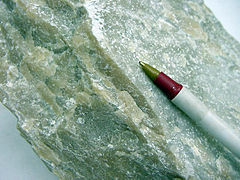Brucite
| Brucite | |
|---|---|
 |
|
| General | |
| Category | Oxide mineral |
|
Formula (repeating unit) |
Mg(OH)2 |
| Strunz classification | 4.FE.05 |
| Crystal system | Trigonal |
| Crystal class | Hexagonal scalenohedral (3m) H-M symbol: (3 2/m) |
| Space group | P3m1 |
| Unit cell | a = 3.142(1) Å, c = 4.766(2) Å; Z = 1 |
| Identification | |
| Color | White, pale green, blue, gray; honey-yellow to brownish red |
| Crystal habit | Tabular crystals; platy or foliated masses and rosettes – fibrous to massive |
| Cleavage | Perfect on {0001} |
| Fracture | Irregular |
| Tenacity | Sectile |
| Mohs scale hardness | 2.5 to 3 |
| Luster | Vitreous to pearly |
| Streak | White |
| Diaphaneity | Transparent |
| Specific gravity | 2.39 to 2.40 |
| Optical properties | Uniaxial (+) |
| Refractive index | nω = 1.56–1.59 nε = 1.58–1.60 |
| Birefringence | 0.02 |
| Other characteristics | Pyroelectric |
| References | |
Brucite is the mineral form of magnesium hydroxide, with the chemical formula Mg(OH)2. It is a common alteration product of periclase in marble; a low-temperature hydrothermal vein mineral in metamorphosed limestones and chlorite schists; and formed during serpentinization of dunites. Brucite is often found in association with serpentine, calcite, aragonite, dolomite, magnesite, hydromagnesite, artinite, talc and chrysotile.
It adopts a layered CdI2-like structure with hydrogen-bonds between the layers.
Brucite was first described in 1824 and named for the discoverer, American mineralogist, Archibald Bruce (1777–1818). A fibrous variety of brucite is called nemalite. It occurs in fibers or laths, usually elongated along [1010], but sometimes [1120] crystalline directions.
A notable location in the U.S. is Wood's Chrome Mine, Cedar Hill Quarry, Lancaster County, Pennsylvania. Yellow and white brucite with a botryoidal habit has been found in Kharan District, Pakistan. Brucite also occurs in the Bela Ophiolite of Khuzdar District, Pakistan.
...
Wikipedia
